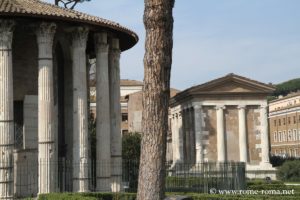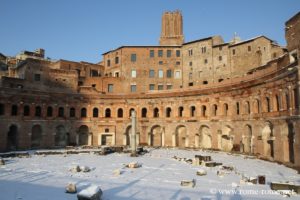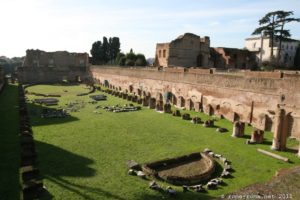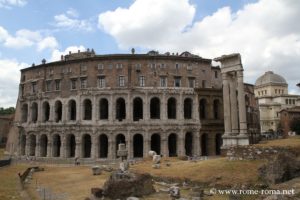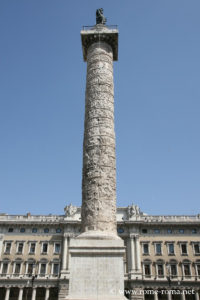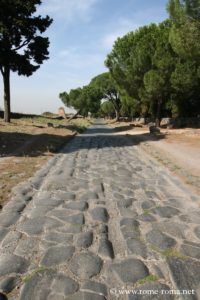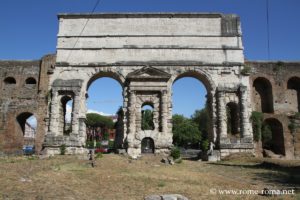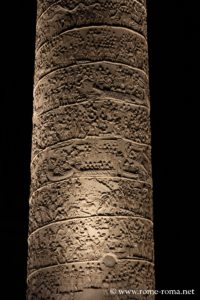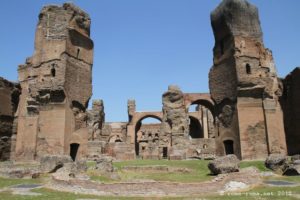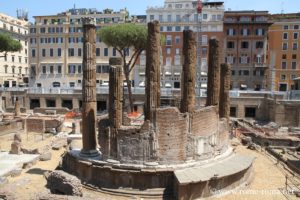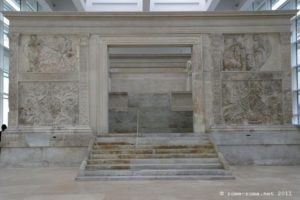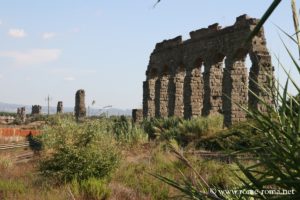After the three great sites of antiquity in Rome – the Colosseum, the Pantheon and the Roman Forum – here is a non-exhaustive list of the ancient monuments of Rome that best evoke the prestigious past of the capital of the Roman Empire.
Beyond these, there are elements in many churches, such as columns and capitals; in many facades also and in the underground, several large Egyptian obelisks, Roman gates, etc.
List of ancient places and monuments
1. Boarium Forum
The Boarium Forum is located near the current Piazza della Bocca della Verità. It was the site of an ancient port market where remained magnificent temples and remains of buildings. Towards the Capitolium is the Velabrum whose beautiful Arch of Janus with its four passages, and a little more the ancient passage of the Arcus Argentariorum.
2. Imperial Forums
The Imperial Forums are located opposite the Roman Forum, from which they are separated by the avenue of Via dei Fori Imperiali which also covers a good part of it. They are more recent than the republican forums, first with the Forum of Caesar, then the forums of Augustus, Vespasian, Nerva and Trajan. The latter, the Forum of Trajan, is with its markets and its most grandiose column. Its superb Trajan’s Column consists of carved blocks that tell the story of the emperor’s military campaigns against the Dacians.
3. Baths of Caracalla
The Baths of Caracalla are one of the most grandiose examples of the imperial baths, of which a large part of the structure is preserved, unfortunately few ornaments present on site, nor the ceilings. They could accommodate 1,500 people, with a central body measuring 220 by 114 meters, and exterior walls of more than 300 meters in length.
4. Appian Way
The Appian Way (Via Appia Antica) extends south-east of Rome crossing for several kilometers a green and agricultural setting. This Roman road keeps portions of the Roman pavement. Walking along it is a fascinating immersion into the past. It is lined with numerous burials and some ancient and medieval buildings, including catacombs, the Villa of Maxentius, the Mausoleum of Cecilia Metella. Included in the Archaeological Park of Via Appia Antica, it is one of the most beautiful sites of the city, to discover on foot or ideally by bike. Nearby are also the vast Park of the Caffarella, the tombs of the Via Latina, or the Park of the Aqueducts.
5. Mausoleum of Hadrian
The Mausoleum of Hadrian is a large cylindrical structure, which became the central base of the Castel Sant’Angelo after the Roman Empire.
6. Palatine hill
The Palatine hill overlooks the valley of the Roman Forum, one of the places where the first villages developed, where the Roman emperors built their sumptuous remains which discover beautiful remains.
7. Aurelian Walls
The Aurelian Walls were built quickly between 270 and 273 by the emperor Aurelian to face the threats of the barbaric attacks of that time. The city had indeed expanded far beyond the ancient Servien Walls. They have incorporated ancient buildings such as houses, monuments or the aqueduct of the Acqua Claudia.
Of the 19 km of walls, 12.5 km remain today, with many gates, often fortified and modified over time. Among the most beautiful are the gates of Porta San Paolo, Porta San Sebastinao, Porta Maggiore, Porta Tiburtina and Porta Asinaria.
8. Theatre of Marcellus
The Theatre of Marcellus is the only ancient stone theatre in Rome of the three that existed, of which significant remains have survived. It had various functions over time, as a fortress, then palace with rooms built above the lower arcades. In the 20th century shops still occupied the arcades overlooking the street.
9. Porticus Octaviae
the Porticus Octaviae, near the previous theatre, on the outskirts of the ghetto, is a beautiful part of a vast ancient portico, located on the outskirts of the old ghetto district.
10. Arch of Constantine
Near the Colosseum and the Roman Forum, the Arch of Constantine is the largest triumphal arch in Rome, built in part by recovering elements and ornaments from older buildings.
11. Baths of Diocletian
The Baths of Diocletian are other vast baths, of which grandiose vaults are preserved, part was converted into the church of Santa Maria degli Angeli, and another houses today the National Roman Museum.
12. Ara Pacis Augustae
The Altar of Augustan Peace, the Ara Pacis, was a superb building built under Augustus, north of the plain of the Campus Martius, dedicated to the goddess of peace, where the returning commanders of the military campaigns came to perform the rites of end of warrior activity. It is not days visible inside a glazed structure.
13. Early Christian Catacombs
The Early Christian Catacombs are numerous in Rome. The main ones are those of Saint Callixtus, Domitilla and San Sebastian located along the Appian Way, then those of Priscilla on the Via Salaria.
14. Sanctuary of Largo Argentina
The sanctuary of Largo Argentina, dating back to the Roman Republic, preserves among the oldest remains of temples in Rome, from the 3rd-4th centuries BC.
15. Ancient aqueducts
The remains of the ancient aqueducts, including those of the Park of Aqueducts, can be found in several parts of Rome.
16. Roman Houses of Caelius
The Roman Houses of Caelius are located on the Caelius hill, under the church dedicated to the brothers John and Paul. It is one of the most fascinating places of underground Rome, which testifies to the occupation of places from the 1st to the 5th century of our, from the pagan era to Christianity, with pretty frescoes.
17. Column of Marcus Aurelius
The Column of Marcus Aurelius was erected on the Campo Marzio after the death of Emperor Marcus Aurelius between 180 and 193 AD. This 30-metre high engraved column celebrates the Emperor’s victorious campaigns against the Germans and the Sarmates.
18. Temple of Hadrian
The Temple of Hadrian was located in what is now Piazza di Pietra. A colonnade today supports a wall of the trade exchange.
19. San Nicola in Carcere
San Nicola in Carcere, near the Forum Boarium, is one of the most amazing churches, built on the remains of three ancient temples of which it incorporates colonnades in its walls.
20. Egyptian Obelisks
The Egyptian obelisks, which usually adorn prestigious squares in Rome, including the most beautiful: the Lateran obelisk (32 m), the Flaminio obelisk (26 m), the Montecitorio obelisk (22 m), the Agonal obelisk (16.5 m) and the Sallustiano obelisk (13.9 m) which have beautiful hieroglyphs, then large obelisks without inscriptions with the Vatican obelisk (25 m), the Esquiline obelisk (14.75 m), and the Quirinal obelisk (14.6 m), then other smaller ones: Pincio (9.7 m), Minerva (5.50 m), Rotonda (6.34 m), Dogali (6.34 m) and Villa Celimontana (2.7 m)
Map with monuments
If you see this after your page is loaded completely, leafletJS files are missing.







